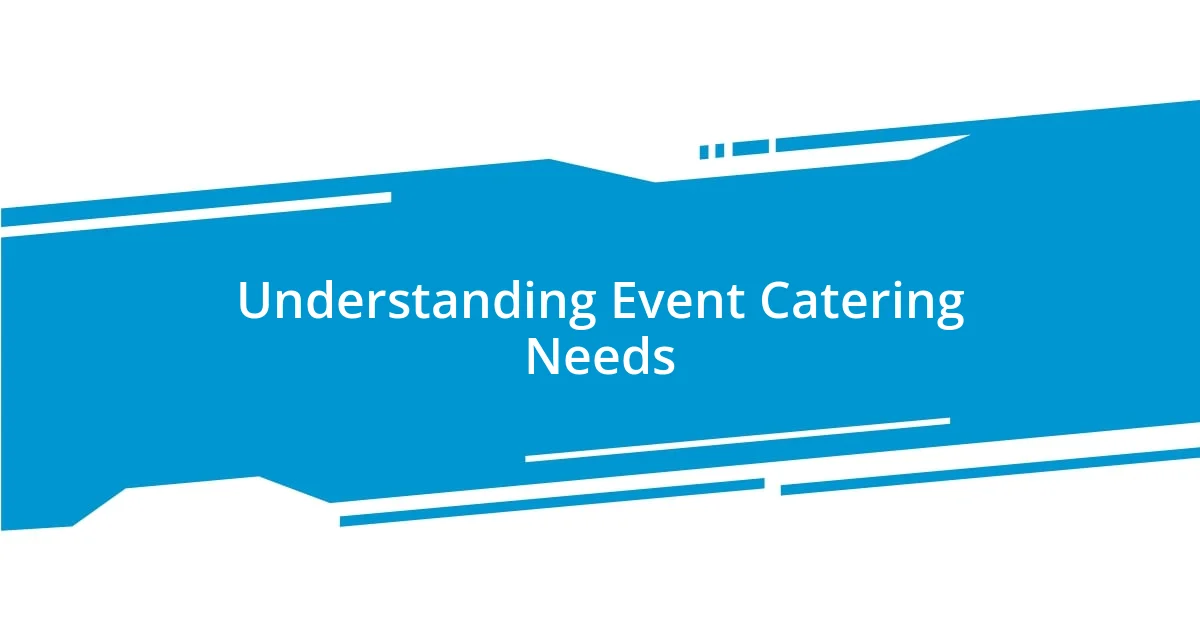Key takeaways:
- Understanding guest needs, event type, and logistics is crucial for successful catering.
- Effective guest list planning enhances group dynamics and contributes to a positive event atmosphere.
- Clear communication with caterers and meticulous event day management ensure a smooth experience and adaptability to unexpected challenges.

Understanding Event Catering Needs
When it comes to catering for an event, understanding the specific needs of your guests is paramount. I recall a wedding where the bride was adamant about accommodating gluten-free options; it turned out to be a game-changer. Have you ever noticed how different dietary preferences can affect the mood of an event?
Identifying the type of gathering you’re hosting also plays a crucial role. Is it a formal gala or a casual get-together? I remember organizing a corporate retreat where the relaxed lunch buffet sparked creativity among attendees. It’s fascinating how the right food can set the tone and enhance the overall experience.
Consider the logistics as well—venue size, timing, and guest count all impact your catering strategy. One time, I underestimated the number of guests at a reunion, leading to a frantic late-night scramble for pizza. Have you had a moment like that? Planning ahead can save you from those last-minute flurries and ensure everyone enjoys the event.

Planning Your Guest List
When creating your guest list, remember that it’s not just about the number of people but also about the dynamics of your group. I once hosted a milestone birthday party and invited every friend I could think of. What I didn’t anticipate was the mix of personalities—some guests were introverted while others were extroverts, leading to a lull in conversations. It’s essential to consider how your guests will interact.
I’ve found it helpful to categorize guests into different groups, such as family, friends, or colleagues. This way, it becomes easier to visualize how each group can mesh during the event. One time, I made a subtle seating arrangement that placed quieter friends next to more outgoing ones, which sparked delightful conversations that flowed throughout the evening. Have you ever tried a similar strategy?
Creating a guest list is also an opportunity to think about your event’s goals and the atmosphere you want to create. When I organized an intimate dinner, I was intentional about my choices. Each invitee was someone I believed would contribute positively to the atmosphere, and it absolutely made a difference in how the night unfolded. Tailoring your list can elevate the experience for everyone involved.
| Considerations | Details |
|---|---|
| Group Dynamics | Understanding how different personalities interact helps create a lively atmosphere. |
| Categorization | Classifying guests into groups aids in effective planning and ensures better conversations. |
| Event Goals | Aligning guest selection with the desired atmosphere contributes to a memorable event. |

Choosing the Right Catering Style
Choosing the right catering style can make all the difference in how your event is perceived and enjoyed. I once attended a winter gala where the caterers opted for a formal plated service. The ambiance felt sophisticated and luxurious, but after a long wait, I realized that not everyone was comfortable being still for so long. I learned that matching the catering style not only to the event but also to the guests’ preferences is crucial in creating a memorable experience.
Here are some catering styles to consider:
- Buffet: Encourages mingling and allows guests to serve themselves. I witnessed this at a friend’s wedding; the relaxed atmosphere made it easy for guests to connect over shared dishes.
- Family-style: Tactile and engaging, this allows guests to pass dishes around the table, fostering a sense of togetherness. At a reunion dinner I hosted, it sparked conversations as family members shared their favorite dishes.
- Plated service: Offers a touch of elegance but can feel restrictive. I remember a formal corporate event where the seating felt stifled; it’s essential to gauge if your guests will appreciate the formality.
- Food stations: Great for varied tastes, these can be themed or catered to specific preferences. I’ve seen this done wonderfully at casual parties where each food station told a story, enhancing the overall experience.
Adapting your catering style to your event’s vibe and guest interactions is not just practical; it’s a way to ensure that everyone leaves with fond memories of the food and connections made over the meal.

Budgeting for Your Catering
Budgeting for catering can feel daunting, but it doesn’t have to be overwhelming. In my early event planning days, I dove headfirst into catering without a clear budget, which was eye-opening. After I went over budget for my sister’s wedding, I learned the hard way to itemize costs before I even started searching for caterers. What’s been the biggest game-changer for me is creating a detailed spreadsheet that includes everything from food and beverages to service fees. It helps keep track of my spending and prioritize what’s essential.
I often recommend setting aside a portion of your budget for unexpected expenses. When I catered a corporate event, we faced an unforeseen surge in guest numbers just days before the occasion. Having a buffer allowed me to accommodate the surprise visitors without panic. It’s always worth asking your caterer about their cancellation or modification policies so you know how flexible the budget can be. Have you ever had to deal with surprises in your budget?
Also, consider the season and local events when planning. I once chose a seafood menu for an outdoor summer gathering, only to discover that prices skyrocketed due to a local festival that week. By keeping tabs on local happenings, I ensure that I tap into seasonal ingredients that not only save costs but also enhance flavor. This way, I find that budgeting becomes less about restrictions and more about strategic choices that elevate the dining experience.

Selecting Menu Options Wisely
Selecting menu options wisely is all about combining practicality with personal taste. I remember curating a menu for a friend’s milestone birthday. Initially, I was tempted to include all her favorite dishes, but I quickly realized that variety is key. Balancing flavors and dietary restrictions ensured that every guest felt included, and it turned the meal into a delightful experience rather than a source of stress.
When crafting a menu, I find that seasonal ingredients create more than just a beautiful plate—they can elevate the entire event’s ambiance. For a spring garden party I organized, I sourced fresh produce from a local farmer’s market. The vibrant colors and flavors not only impressed the guests but stirred nostalgic memories of childhood picnics. Have you ever found that the right ingredients can evoke emotions and create memorable moments? Trust me, it’s a game changer.
It’s also crucial to think about the flow of the event while selecting menu options. I once hosted an open house and aimed for an easy grazing experience. Small, hand-held bites allowed guests to mingle freely, making conversations flow effortlessly. A well-thought-out menu can serve as a facilitator for connections, enhancing both the food and the overall atmosphere. What I learned is that making conscious choices about the menu can truly transform how an event feels to everyone involved.

Coordinating With Your Caterer
Coordinating effectively with your caterer can really make or break an event. I vividly recall working with a caterer for my own engagement party. We scheduled multiple meetings to discuss not just the menu, but also the flow of the evening. Being transparent about my vision and listening to their suggestions made the process collaborative. Have you ever thought about how communication styles can shape event outcomes?
It’s crucial to establish a timeline with your caterer. For instance, while planning a charity fundraiser, I learned to break down tasks into clear deadlines. By setting a timeline for menu finalization, tastings, and delivery times, we avoided last-minute hiccups. I also made it a point to check in regularly, which not only kept everyone on track but also fostered a relationship built on trust and understanding. What about you—do you find regular check-ins help in prompting timely decisions?
Don’t underestimate the power of site visits! I once coordinated a wedding reception at a venue that had a stunning outdoor garden. My caterer and I visited the location together, allowing us to discuss logistics like kitchen access and serving locations firsthand. This proactive approach helped adapt our plans to the space better, ultimately leading to a smoother execution on the event day. Have you had any experiences that shaped your approach to planning?

Managing Event Day Tasks
Managing event day tasks requires careful organization and a level-headed approach. On one occasion, I managed a corporate gala, and I learned the significance of a well-defined task list. It included everything from checking the seating arrangements to ensuring that the sound system was operational. Feeling a sense of control on the day of an event allows for unexpected challenges to be addressed without panic.
Preparing for the unexpected can’t be overstated. I once organized a wedding where the cake delivery was delayed. Thankfully, I had arranged for a backup dessert option. This not only eased the stress of the moment but also kept the celebration on track. Have you ever dealt with a surprise that turned into a blessing in disguise? I truly believe that flexibility is just as important as planning.
In the hustle of an event, I find that delegating tasks is crucial. During a family reunion I orchestrated, I assigned responsibilities to my relatives based on their strengths. One cousin excelled at managing the drink station, while another took charge of greeting guests. This shared responsibility lightened the load for me and created an atmosphere of teamwork. It’s remarkable how empowering others can lead to a more enjoyable experience for everyone. How do you typically involve others in your planning process?
















